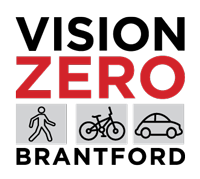
The role of technology and data in road safety and Vision Zero interventions
This page was last reviewed on September 26, 2022
To gain a better understanding of the role of technology in implementing Vision Zero, we spoke with David Ferguson, the Manager of Traffic Services with the City of Brantford. With more than 20 years of experience in municipal transportation in five municipalities, David has led multiple projects related to roadway safety and Vision Zero. David supports the use of technology to assist practitioners in improving road safety for all road users.
Why is it important to implement new data collection technologies in cities?
Technology is advancing very quickly and companies are developing programs that make evaluation of the transportation network easy and seamless. It is important to explore these new technologies to assist transportation professionals in evaluating the operations and safety of the road network and to help them make good decisions using a data-driven approach to improve roadway safety for all users.
What role has technology played in implementing Vision Zero?
It is an exciting time to be in the transportation industry as technology is leading the way to improving roadway safety and assist professionals in meeting their VZ goals. These new programs and products allow organizations to monitor and develop metric reports to identify specific problem areas to focus funding and resources. Through the use of technology, locations can quickly be analyzed, countermeasures identified and implemented to reduce serious injuries and fatalities. With the increasing demand in automated enforcement, these products have shown to have a clear positive improvement in reducing serious collisions and reducing speeds and will become more important in the years to come as Police Services find it difficult to conduct regular traffic enforcement.
How have you used the data collected to get buy-in from key stakeholders?
Data is one of the key foundations to VZ as it helps to guide staff in the proper direction. Data can come in various forms, from something as simple as a public survey to using AI technology and GIS mapping to identify deficiencies in the road network. These various data tools and metrics they produce are important when dealing with various stakeholders as they provide substance and clear information to gain stakeholder support in recommendations that staff are bringing forward. This area a crucial component in any VZ program: the more you have support from stakeholders, then the better opportunity you will have for success.
What are some key successes of implementing new data collection technologies in cities?
One of the key successes I have been involved with was the development of network screening and ranking. This allowed us to evaluate our road network and compare apples to apples so that we were able to focus our resources to the highest collision locations. Secondly would be the use of video analytics and AI technology to identify issues at specific signalized intersections and recommend remedial action.
What are some of the challenges with implementing new data collection technologies in cities?
The biggest issue for municipalities that I have experienced, especially at smaller municipalities, is lack of funding and the need to follow procurement policies. The process can sometimes be longer than needed and time-consuming.
How did you overcome these challenges?
Working with companies to assist in meeting our needs to complete studies, investigating grants and funding opportunities, and using revenue from automated enforcement programs to fund traffic safety initiatives.
If you had limited funding, what would be the one technology solution you would recommend and why?
Based on my years of experience, one of the biggest advancements I have seen is with video analytics and artificial intelligence analysis of intersections. The benefits of undertaking these studies and being able to identify remedial actions has the greatest safety benefits. Safety enhancement at signalized intersections are identified as having the greatest benefit to improve overall safety and assist in meeting the targets of Vision Zero.
What organizations or companies are leading the way in road safety technology and what types of data do they collect?
There are a number of organizations throughout North America leading the way using technology to meet their VZ needs. Portland, Oregon, Bellevue, Washington, Toronto, Ottawa and Surrey B.C. are some municipalities that come to mind. As for companies, several are bring forward new technologies to assess things such as traffic operations, volumes and speeds.
What advice do you have for cities thinking about using technologies to collect data?
My biggest advice is for cities to first develop a plan and identify what are their needs or areas that they wish to focus on first. Road safety and Vision Zero is not a one-year plan: improving road safety is a long-term program and it can evolve and change from year to year. Focus on the top priorities and follow through with your programs based on a developed plan. Improvements at intersections controlled by traffic signals have the biggest opportunity for safety improvement, along with addressing pedestrian issue locations. In a previous study I conducted, we determined that when a pedestrian was involved in a collision, there were injuries in excess of 80 per cent of the time. If you can implement measures to improve safety for pedestrians, you could technically reduce injuries by 80 per cent, which is well on route to the VZ goal.
Another important part of VZ is that it is not a single department program. It needs to involve the entire organization and everyone needs to be part of implementing solutions: engineering, development, public health, school boards, police and communications.